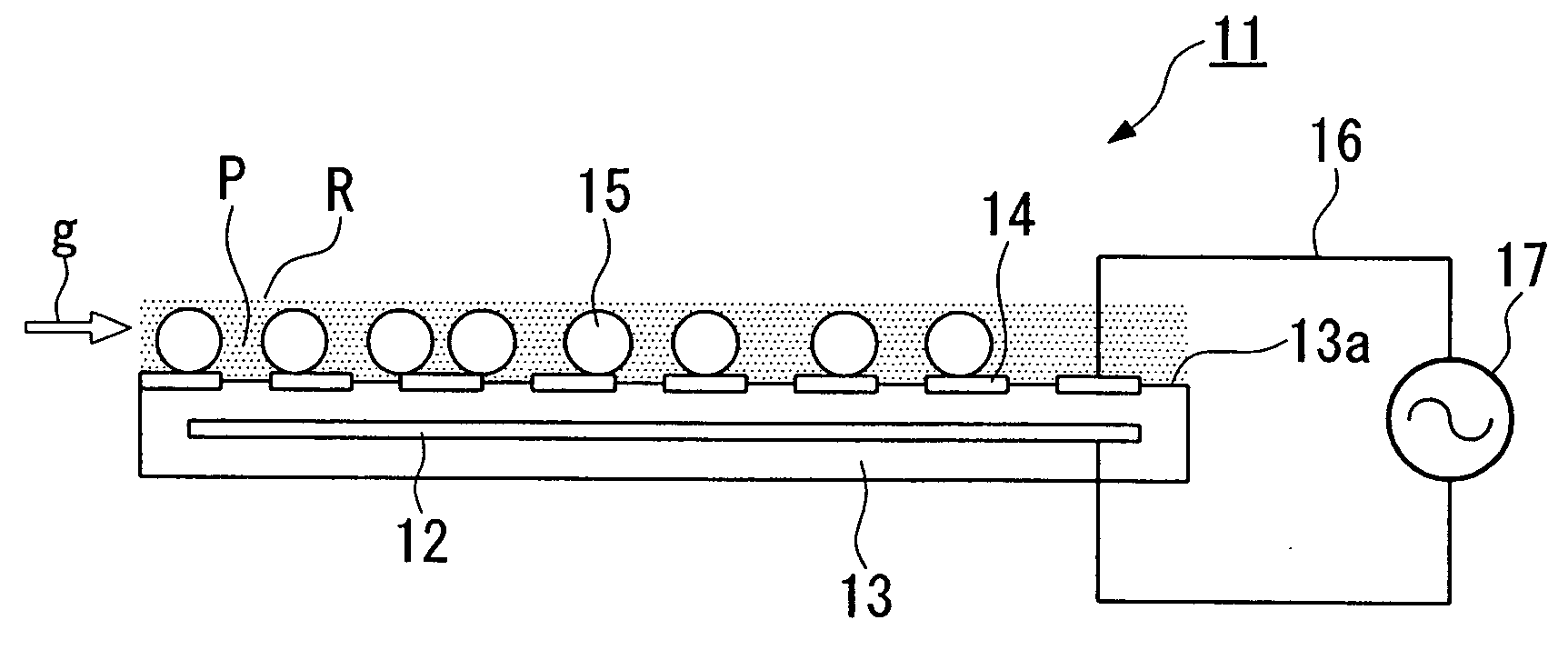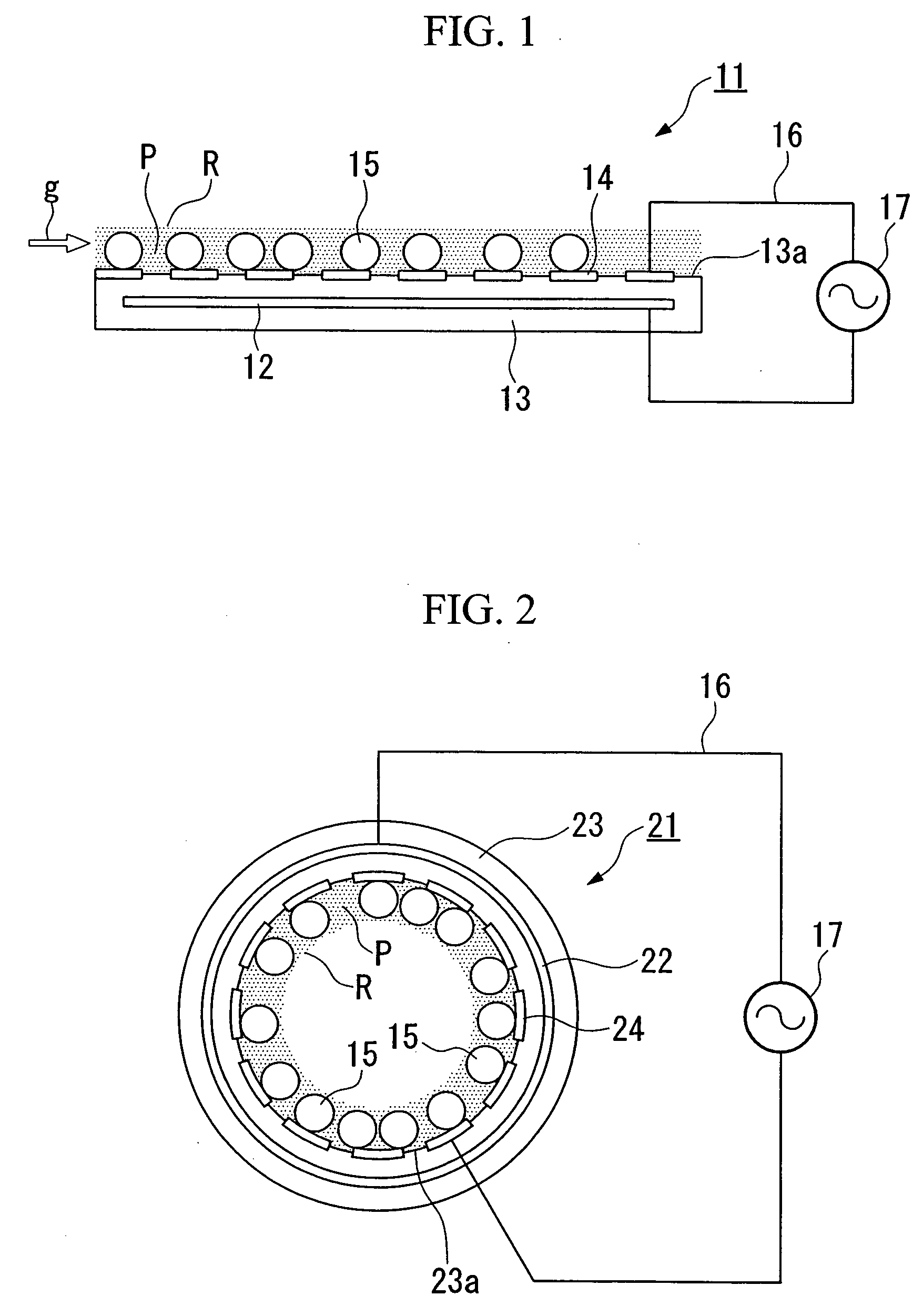Method and apparatus for gas treatment using non-equilibrium plasma
a plasma and gas treatment technology, applied in the direction of physical/chemical process catalysts, metal/metal-oxide/metal-hydroxide catalysts, separation processes, etc., can solve the problems of low efficiency of decomposition treatment, and inapplicability, so as to improve the decomposition efficiency of treated gas and efficiently decompose
- Summary
- Abstract
- Description
- Claims
- Application Information
AI Technical Summary
Benefits of technology
Problems solved by technology
Method used
Image
Examples
first embodiment
1. First Embodiment
[0044]FIG. 1 diagrammatically shows the constitution of a surface discharge electrode for use in a gas treatment apparatus in accordance with a first embodiment of the invention.
[0045] A surface discharge electrode 11 shown in FIG. 1 is roughly formed as a planar plate electrode having a disk-like shape, wherein it comprises a ground electrode 12 having a thin disk shape, an insulator 13 having a thick disk shape encompassing the ground electrode 12, a plurality of spiral surface electrodes 14 formed on an upper surface (or a main surface) 13 a of the insulator 13, and a plurality of photocatalyst members 15 each containing photocatalyst and solid substance (excluding photocatalyst), which are arranged in a non-equilibrium plasma region R, wherein the ground electrode 12 and the surface electrode 14 are connected with a power source 17 via wires 16.
[0046] The aforementioned surface discharge electrode 11 is not necessarily limited in the outline shape and size t...
second embodiment
2. Second Embodiment
[0079]FIG. 2 diagrammatically shows the constitution of a surface discharge electrode for use in a gas treatment apparatus in accordance with a second embodiment of the invention, wherein parts identical to those of the first embodiment shown in FIG. 1 are designated by the same reference numerals.
[0080] A surface discharge electrode 21 comprises an ground electrode 22 having a pipe-like shape (or a cylindrical shape) composed of a conductive material, an insulator 23 having a pipe-like shape (or a cylindrical shape) composed of an insulating material, which encompasses the ground electrode 22 in a closed state, and a plurality of surface electrodes 24 each having a stripe shape that are arranged on an interior circumferential wall 23a of the insulator 23 in a coaxial manner with the ground electrode 22, as well as a photocatalyst member 15 (including photocatalyst and solid substance) arranged in a non-equilibrium plasma region R on the surface electrode 24. Al...
third embodiment
3. Third Embodiment
[0084]FIG. 4 is a cross sectional view showing essential parts of a gas treatment apparatus in accordance with a third embodiment of the invention, wherein parts identical to those of the first embodiment shown in FIG. 1 are designated by the same reference numerals.
[0085] A gas treatment apparatus 31 is installed in an exhaust pipe arranged in an incinerator for treatment of general waste and industrial waste, wherein a plurality of surface discharge electrodes 34 (FIG. 4 shows three sets of surface discharge electrodes 34 arranged in parallel with prescribed distances therebetween) are arranged in a non-equilibrium plasma region R actualized by a treated gas g inside of an exhaust pipe 35 in such a way that they block the exhaust flow in the exhaust pipe 35. The space between the adjacently arranged surface discharge electrodes 34 is filled with photocatalyst members 15 each including photocatalyst and solid substance. The surface discharge electrode 34 compris...
PUM
| Property | Measurement | Unit |
|---|---|---|
| specific surface area | aaaaa | aaaaa |
| specific surface area | aaaaa | aaaaa |
| specific surface area | aaaaa | aaaaa |
Abstract
Description
Claims
Application Information
 Login to View More
Login to View More - R&D
- Intellectual Property
- Life Sciences
- Materials
- Tech Scout
- Unparalleled Data Quality
- Higher Quality Content
- 60% Fewer Hallucinations
Browse by: Latest US Patents, China's latest patents, Technical Efficacy Thesaurus, Application Domain, Technology Topic, Popular Technical Reports.
© 2025 PatSnap. All rights reserved.Legal|Privacy policy|Modern Slavery Act Transparency Statement|Sitemap|About US| Contact US: help@patsnap.com



